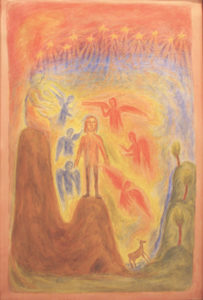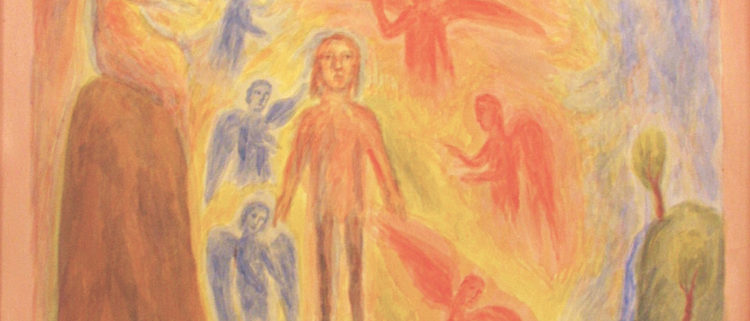are we the walking dead? Finding the Way to Truth and Meaning

By Tommi Morgan
This article appeared in our Winter 2016 issue. Click here to buy a copy.
So many young people today are searching for a path that inspires and allows them to be true to their unfolding ideas and ideals. Not so long ago the path was clearly marked by the many feet that went before. Upon reaching adulthood, one could choose to follow one of the established paths: college, career, and white picket fence; or choose to rebel and break new ground. Now, however, there is no clear path to follow or to reject. The old paths are hard to find and often lead nowhere, while the new paths are not clearly defined. Education has not equipped us with the tools needed to find hidden paths or to carve our own. For some, the path of spiritual science, outlined by Rudolf Steiner, offers tools for both.
All philosophy, science, psychology, and religious study are the result of humanity’s quest for truth and meaning; our search for “the way.” Bookstore and library shelves are bursting with guidelines for meditation, self-improvement, religious analyses and doctrines. The choices these days are dizzying; there is a smorgasbord of churches, spiritual teachers, psychological techniques, workshops, and retreat centers based on ancient traditions or “new age” teachings. Meditation techniques are being taught in schools to decrease student stress; in athletic training to improve performance; and in the business sector to increase effectiveness. Brain research clearly shows observable changes in the brain structure of those who meditate consistently over time. Scientific literature dissects our every experience down to the cell, telling us what to eat, how to move, and what to believe. Although following these “ways” may improve our immediate health and effectiveness in our day-to-day lives, is it helping us find truth and meaning?
TS Eliot asked, “Where is the Life we have lost in living? Where is the wisdom we have lost in knowledge? Where is the knowledge we have lost in information?” 1
"The answers are as varied as the individual seekers."
Shelves on the other side of the bookstore sag under the weight of apocalyptic science fiction, in which elements of our modern world are exaggerated, emphasized, or taken imaginatively to the extreme. In these tales, things that are regarded as progress, or as harmless in our present world, lead to our demise. The recurring question is … what can save us from ourselves? The Walking Dead, a wildly popular television program, shows us a world in which human beings are transformed into zombies who, without thinking or feeling, go about satisfying their bodily needs. Most frightening is what a true picture this paints of modern society when there is no sense of meaning; and when higher consciousness is dulled by so many environmental triggers and addictions: school bells, video games, cell phones, television, trashy novels, even work addiction. From morning coffee and a nightcap, to marijuana; and even heroin addiction is everywhere. The pain of our longing for truth and meaning is quickly pacified by a multitude of consciousness-dulling activities and substances.
We long for meaning but then choose pacifiers or tranquilizers because reality seems just too painful; looking at our lives with wide-open eyes seems too much to bear. What we fail to realize is that anesthetizing against the pain kills the joy as well, and hides from us our true selves, veiling signs of truth and meaning. Still, a book off the shelf with rules to live by, and recipes by which to interpret the world and our experiences will not truly satisfy. The modern human being seeks living experience, proof by which to discover and create his or her own meaning. The modern human being wants to be touched by something real that wakes the inner knowing, the inner guide. The time of the guru is past; and yet we are often blind and deaf to the inner guidance available to us. We must learn to take ourselves in hand, and cultivate in ourselves perceptivity and discernment of things that will strengthen us inwardly. No one else can do this for us.
"We long for meaning but then choose pacifiers or tranquilizers because reality seems just too painful."
In the early 1500s, Martin Luther wrested scripture from the control of the church, making it accessible to the common person, so that we did not need pope or pastor as mediator to spirit. It is now up to the individual human being to loose him/herself from empty tradition, from unconscious habits of thinking, in all of its forms, so that we might see through clear eyes. Emerson, too, challenged us to find our own way.
"The foregoing generations beheld God and nature face to face; we, through their eyes. Why should not we also enjoy an original relation to the universe? Why should not we have a poetry and philosophy of insight, and not of tradition; and a religion by revelation to us, and not the history of theirs? …. why should we grope among the dry bones of the past, or put the living generation into masquerade out of its faded wardrobe? The sun shines today also. There is more wool and flax in the fields. There are new lands, new men, new thoughts. Let us demand our own works and laws and worship.” 2
This call for self-liberation is echoed in the work of Rudolf Steiner. Steiner’s spiritual science is not an ideology to be taken on faith; rather it can be seen as one man’s personal experience along with a set of tools which anyone can take up, so that each can each find his or her own way to truth in freedom. This way of learning is foreign to many of us who have grown up learning by rote, learning not to question our teachers, our pastors, or our scientists. Many have learned to follow, to turn to outer authority for guidance, without ever waking our inner authority. We have learned to fear the unknown, to fear not knowing and to fear the very changes that we long for. The result often has been that we join the zombies by numbing our minds and our feelings; or choose a path like anthroposophy, then read, study, diagram, and quote Steiner verse and line. We forget his insistence that we make the path our own, that we must engage our will, move the thoughts into our hearts, recreating them as our own, lest these thoughts become dry and dusty bones as those that came before. Our cleverness can be an obstacle.
Rudolf Steiner said, “When someone studying anthroposophy says it leaves him cold, he reminds me of one who keeps piling wood in the stove and then complains that the room doesn’t get warm. Anthroposophy can be presented, and it is the good wood of the soul; but it can be enkindled only by each within himself. What everyone must find in his Gamut [individuality] is the match wherewith to light anthroposophy. And just as only a little match is needed to light ordinary wood, so anthroposophy too, needs only a little match.” 3
How do we avoid becoming one of the walking dead? How do we overcome the obstacles we put in our own path daily? How do we find the wood and the spark with which to kindle it? How do we make the way our own?
The answers are as varied as the individual seekers.
If you are reading this article, you have by accident or design found the way of spiritual science as described by Rudolf Steiner. It is a path, which, if actively engaged, demands that you make it your own. It is an invitation that tickles, urges, or demands, inspires, and even enflames; that draws you along, that demands courage, faith and fortitude. You must find and cultivate inner strength to take up the work, by and for yourself. In her “Fight Song,” pop singer Rachel Platten reminds us “…how a single word can make a heart open. I might only have one match but I can make an explosion. This is my fight song, take back my life song, prove I'm alright song. My power's turned on; starting right now I'll be strong, And I don't really care if nobody else believes.” 4
"The modern human being seeks living experience, proof by which to discover and create his or her own meaning."
Toward this end Steiner offered a variety of exercises that allow the seeker to:
- learn to direct his or her own thoughts through the practice of concentration;
- cultivate an awareness of the many feelings a human being experiences, without involuntary expression of those feelings, thus increasing both sensitivity and self-awareness;
- cultivate the capacity to act rather than react, freeing ourselves from unconscious activity and making us more conscious and responsible in our choices.
These exercises are prerequisites, tools which give us strength and insight to find our own way in the search for truth and meaning. (For further exploration of these exercises see sources referenced below.)
Finding our own way is hard work, but like most hard work it is rewarding and ultimately invigorating, giving us a stronger sense of Self, truth, and meaning.
The wishes of the soul are springing;
The deeds of the will are thriving;
The fruits of life are maturing.I feel my destiny;
My destiny finds me.
I feel my star;
My star finds me.
I feel my goals in life;
My goals in life find me.My soul and the great world are one.
Life grows more radiant around me;
Life grows more arduous for me;
Life grows more abundant within me. —Rudolf Steiner, Truth Wrought Words
A few books for inspiration, exploring the path of spiritual science:
- Knowledge of Higher Worlds and Its Attainment, Rudolf Steiner
- Guidance in Esoteric Training, Rudolf Steiner
- From Normal to Healthy: Paths to the Liberation of Consciousness, Georg Kuhlewind, translated by Michael Lipson
- Stairway of Surprise, Michael Lipson
- Enlivening the Chakra of the Heart, Florin Lowndes
REFERENCES:
1. T. S. Eliot, “Choruses from The Rock.” Public domain.
2. Ralph Waldo Emerson, Selected Essays, Lectures, and Poems (NY: Bantam/Dell Publishers, 1990) 15.
3. Rudolf Steiner, Michaelmas and the Soul Forces of Man (Great Barrington, MA: Anthroposophic Press, 2012) 31.
4. Rachel Platten, http://www.directlyrics.com/rachel-platten-fight-song-lyrics.html
5. Steiner, Truth Wrought Words, tr. Arvia MacKaye (Hudson, NY: Anthroposophic Press, 1979).
Tommi Morgan is an educator and educational consultant. She is program director at Sound Circle Center for Arts and Anthroposophy, Seattle, and adjunct faculty at Sunbridge Institute, New York. She teaches and mentors at Waldorf schools in the United States and China. In her spare time she enjoys gardening and playing with her grandson.
Painting "Circulation" by David Anderson.
Sound Circle offers “A Taste of Anthroposophy,” exploration into various subjects from an anthroposophical perspective. www.soundcircle.org/taste-of-anthroposophy




Leave a Reply
Want to join the discussion?Feel free to contribute!